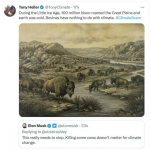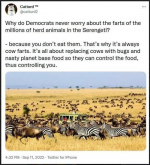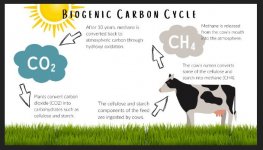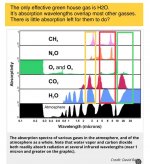Is this like Beano for cows?
---------------------------
U.K. cows could get methane suppressants to limit farm emissions
United Kingdom officials are on a mission to limit the region's impact on global warming and mitigate the impacts of climate change. As part of a large-scale approach to fulfill this goal, there's one area of focus that sticks out: cows.
In March, the government unveiled its Net Zero Growth Plan, an initiative to limit reliance on fossil fuels – the burning of which significantly influences global temperature rise. One of the pathways to seeing this through is a focus on agricultural emissions, the country said, with officials adding in their plan that they are expecting "high efficacy methane suppressing products" to enter the market in 2025 to help. Such products, they said, would be introduced in a "phased approach."
Agriculture and other land-use emissions make up about 11% of the U.K.'s net greenhouse gas emissions, including international aviation and shipping, officials said.
"Livestock (particularly cattle) currently make up the largest share of these emissions," the Net Zero Growth Plan says.
Last year, environmental data company GHGSat captured methane emissions on satellites as they were being released by cows. They recorded five emissions in California's Joaquin Valley and found that if the amount of methane in those emissions were sustained for a year, it would result in 5,116 tonnes of gas, "enough to power 15,402 homes." Experts say these flatulent emissions coming from cattle's bodily processes are mostly from burps.
U.K. officials put out a call in August for agriculture experts to provide information on how animal feed products could reduce methane emissions, such as "methane production inhibitors, seaweeds, essential oils, organic acids, probiotics, and antimicrobials." More than 200 people responded to the call, including NGOs, farmers and businesses, and a summary of those results will be made public later this year.
Tom Bradshaw, deputy president of the U.K.'s National Farmers' Union, told The Guardian that the suppressants being encouraged by officials "could be useful."
"I don't think we know enough yet about the impact they will have on the efficiency of the diet," he said, "but it's something that we have to investigate to try and reduce methane emissions."
Richard Waite, senior researcher at the World Resources Institute, said that while the suppressants could help reduce emissions from cow burps, they "won't fix all the climate and other issue issues related to food systems."
Some consider it a "techno fix," he said, similar to things like LED lightbulbs, electric vehicles and meat alternatives. But while it may be a small change, he said that doing things like this "can be quite useful contributors to solving big problems." "Not every 'solution' needs to change every part of a system to be part of big important changes," Waite tweeted.
And it appears as though this emphasis on cow burps is only one small part of the U.K. government's plans. In February, officials released an update on the Environmental Land Management plan, an agricultural policy reform that aims to revamp how the agriculture sector works with the land.
"Through the Agricultural Transition, we are expanding our schemes to pay farmers and land managers to provide environmental goods and services alongside food production," the update says, "and providing one-off grants to support farm productivity, innovation, research and development in a way that also helps us to achieve these goals."
According to the update, there have so far been hundreds of farmers who have joined the roll out of the plan's implementation, which entails more support and financial incentives and payments for farmers to improve their services, efforts to better tackle pollution and more funding for the Environment Agency, a public body that is responsible for protection and enhancement of the environment.
"These reforms are essential to help us grow and maintain a resilient, productive agriculture sector over the long term," the website for the plan says, "and at the same time achieve our ambitious targets for the environment and climate, playing our role in tackling these huge, global challenges."




